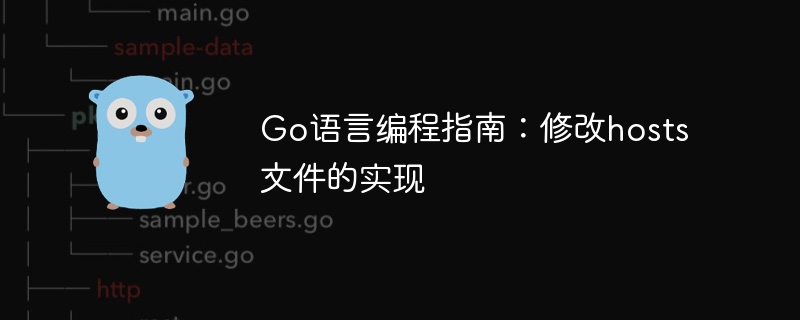Home >Backend Development >Golang >Go Language Programming Guide: Implementation of Modifying Hosts File
Go Language Programming Guide: Implementation of Modifying Hosts File
- 王林Original
- 2024-03-07 10:51:041307browse

Title: Go Language Programming Guide: Implementation of Modifying Hosts File
In the daily software development process, we often encounter the need to modify the hosts file in the operating system. Condition. The Hosts file is a text file without extension used to map IP addresses and host names. It is usually used to set up domain name resolution locally. In this article, we will introduce how to use the Go language to implement the function of modifying the hosts file of the operating system, and give specific code examples.
First, we need to create a Go program that can modify the hosts file. The following is a simple implementation example:
package main
import (
"os"
"io/ioutil"
"strings"
)
func main() {
hostsPath := "/etc/hosts" // hosts文件路径,根据操作系统不同可能有所不同
// 读取hosts文件内容
data, err := ioutil.ReadFile(hostsPath)
if err != nil {
panic(err)
}
// 将文件内容转换为字符串
hostsContent := string(data)
// 添加需要修改的域名和IP映射
newEntry := "127.0.0.1 example.com"
// 检查是否已存在相同的映射,如果存在则不再添加
if !strings.Contains(hostsContent, newEntry) {
hostsContent += "
" + newEntry
}
// 写入修改后的hosts文件内容
err = ioutil.WriteFile(hostsPath, []byte(hostsContent), 0644)
if err != nil {
panic(err)
}
fmt.Println("Hosts文件已成功修改!")
}In the above code, we first read the contents of the hosts file, and then added a new domain name and IP mapping to the file. In actual applications, you can customize the domain name and IP to be modified as needed. Finally, write the modified content back to the hosts file.
It should be noted that since the hosts file is usually located in a protected directory of the system, you may need to execute it with administrator rights or elevated rights when running this program. In Windows systems, you can use the runas command to execute programs, and in Unix-like systems (such as Linux, macOS, etc.), you can use sudo to execute programs.
In addition, if you need to add more hosts entries in the program or implement other hosts file related operations, you can further expand the above code as needed.
In short, through the sample code in this article, you can easily use the Go language to implement the function of modifying the hosts file of the operating system. I hope this article is helpful to you and also provides you with some practical experience on operating system file operations and Go language programming. Happy programming!
The above is the detailed content of Go Language Programming Guide: Implementation of Modifying Hosts File. For more information, please follow other related articles on the PHP Chinese website!

